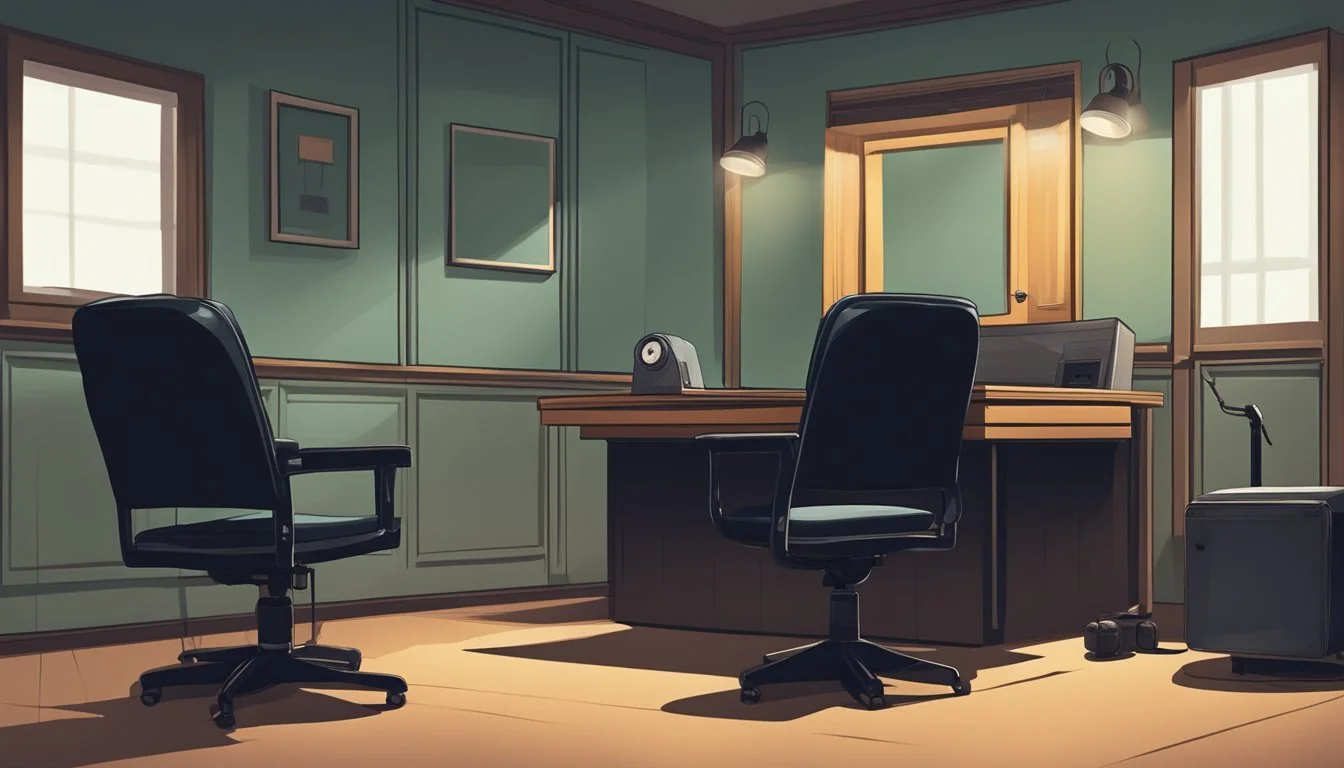Confession Psychology: Analyzing the Menendez Brothers' Admissions
A Deep Dive into Their Courtroom Revelations
The Menendez brothers' case captivated the nation in the early 1990s. Lyle and Erik Menendez were charged with the brutal murders of their wealthy parents in their Beverly Hills mansion. The psychological aspects of their confessions provide a fascinating glimpse into the complexities of criminal minds and the ethical dilemmas faced by mental health professionals.
The brothers' admissions to their therapist, Dr. Jerome Oziel, became a pivotal element in their trial. This breach of patient confidentiality raised significant legal and ethical questions about the limits of doctor-patient privilege in criminal cases. The recorded confessions offered prosecutors crucial evidence, while also shedding light on the brothers' mental states and motivations.
Analyzing the Menendez brothers' confessions reveals the intricate interplay between psychology, law, and ethics in high-profile criminal cases. Their admissions, coupled with their emotional courtroom testimonies, provided a rare opportunity for experts and the public to examine the psychological factors that can lead to such heinous acts.
Background of the Menendez Family
The Menendez family was a wealthy and prominent household in Beverly Hills, California. Their seemingly perfect facade masked complex family dynamics and hidden turmoil that would ultimately lead to tragedy.
Parental Figures: Jose and Kitty Menendez
Jose Menendez was a Cuban immigrant who achieved remarkable success in the entertainment industry. He served as an executive at RCA Records and later became CEO of LIVE Entertainment. Jose was known for his ambitious nature and high expectations for his sons.
Kitty Menendez, born Mary Louise Andersen, was a former beauty queen from Illinois. She married Jose in 1963 and dedicated herself to raising their children. Kitty struggled with depression and substance abuse issues throughout her life.
The couple's relationship was often strained, marked by Jose's infidelity and Kitty's emotional instability. Despite their personal struggles, they maintained an image of success and affluence in their social circles.
Upbringing in Beverly Hills
Lyle and Erik Menendez grew up in the luxurious environment of Beverly Hills. The family's mansion on North Elm Drive symbolized their wealth and status. The brothers attended exclusive private schools and had access to numerous privileges.
Jose pushed his sons to excel in academics and sports, often employing harsh disciplinary methods. He controlled many aspects of their lives, from their education to their social interactions. This pressure created a tense household atmosphere.
Despite their affluence, the Menendez brothers later claimed they experienced emotional and physical abuse behind closed doors. This alleged mistreatment would become a central point in their defense during the murder trials.
The family's public image contrasted sharply with the private struggles they faced, setting the stage for the shocking events that would unfold in August 1989.
The Crime and Subsequent Arrest
The Menendez brothers' case began with a shocking double murder in Beverly Hills and culminated in their dramatic arrests. The events unfolded through a series of twists and turns, from the initial crime to the breakthrough that led authorities to the perpetrators.
Murder on Elm Drive
On August 20, 1989, Jose and Kitty Menendez were brutally killed in their Beverly Hills mansion on Elm Drive. The couple was watching TV in their den when they were ambushed with multiple shotgun blasts. Jose was shot point-blank in the back of the head, while Kitty was shot several times as she tried to escape.
The crime scene was gruesome, with blood spattered across the room. Neighbors reported hearing what sounded like firecrackers, but no one immediately called the police.
Initial Police Investigation
Beverly Hills police initially suspected a mafia hit due to Jose's business connections. They found no signs of forced entry, suggesting the killers were known to the victims. The Menendez brothers, Lyle and Erik, claimed they discovered the bodies after returning from a movie.
Detectives interviewed family members and associates. They also examined the crime scene for evidence, collecting shell casings and analyzing blood spatter patterns. Despite their efforts, the investigation stalled for months.
The Breakthrough and Arrests
The case took a dramatic turn in March 1990 when Erik Menendez confessed to his psychologist, Dr. Jerome Oziel. Oziel's girlfriend later informed police about the confession. This breakthrough led to a renewed investigation focusing on the brothers.
Police monitored the Menendez brothers' activities and spending habits. They noticed lavish purchases and erratic behavior. On March 8, 1990, Lyle was arrested in Beverly Hills. Erik, who was in Israel, surrendered days later upon returning to Los Angeles.
The arrests shocked the affluent community and sparked intense media coverage. The case would soon become one of the most publicized trials of the decade.
Confessions and Therapeutic Revelations
The Menendez brothers' case took a dramatic turn when their confessions came to light through therapy sessions. These revelations exposed crucial details about the murders and raised complex ethical questions.
Dr. Jerome Oziel's Role
Dr. Jerome Oziel, a Beverly Hills psychologist, became a central figure in the Menendez case. Erik Menendez sought therapy from Dr. Oziel shortly after the murders. During these sessions, Erik confessed to killing his parents.
Lyle Menendez later joined the therapy sessions. Dr. Oziel recorded conversations with the brothers, capturing their admissions of guilt. These recordings would become pivotal evidence in the trial.
The therapist's involvement raised ethical concerns about doctor-patient confidentiality. Many questioned whether Dr. Oziel should have reported the confessions to authorities.
The Tapes and Dr. Oziel's Testimony
The recorded therapy sessions became a contentious issue in court. On August 7, 1990, a California judge ruled that the tapes could be used as evidence. This decision significantly impacted the case against the Menendez brothers.
Dr. Oziel's testimony provided insight into the brothers' mental state and motivations. He described their confessions and behaviors during therapy sessions. The psychologist's account painted a complex picture of the brothers' relationship with their parents.
The admissibility of these tapes sparked debate about the limits of confidentiality in therapy. Legal experts questioned whether using such evidence would deter future patients from seeking help.
Judalon Smyth's Discovery
Judalon Smyth, Dr. Oziel's former mistress, played an unexpected role in exposing the confessions. She overheard therapy sessions between Dr. Oziel and the Menendez brothers. Smyth learned about the murders and the existence of the recorded confessions.
Concerned about the information she had discovered, Smyth contacted the police. Her actions led to the seizure of the tapes from Dr. Oziel's office. This revelation drastically altered the course of the investigation.
Smyth's involvement raised questions about the security of confidential therapy sessions. It highlighted the potential risks when personal relationships intersect with professional ethics in psychology.
Legal Proceedings and Trials
The Menendez brothers' case involved complex legal proceedings spanning multiple trials. Key rulings by the California Supreme Court shaped the course of the case, ultimately leading to a final verdict and sentencing.
First Trials and Deadlocks
The initial trials for Lyle and Erik Menendez began in 1993. Separate juries heard the brothers' cases simultaneously. The defense argued self-defense, citing alleged abuse by their father.
Prosecutors sought first-degree murder convictions. They presented evidence of the brothers' lavish spending after the killings.
Both juries deadlocked in January 1994. The first trial for Lyle ended with a 6-6 split on first-degree murder. Erik's jury deadlocked 7-5 in favor of manslaughter.
The California Supreme Court Rulings
The California Supreme Court made crucial rulings that impacted the retrial. In 1995, the court decided to allow some evidence of alleged abuse.
However, the court limited testimony about the brothers' mental states. This ruling restricted the defense's ability to argue imperfect self-defense.
The court also ruled that Lyle and Erik would be retried together with one jury. This decision aimed to avoid conflicting verdicts.
Final Verdict and Sentencing
The retrial began in August 1995. Prosecutors focused on premeditation and financial motives. The defense continued to argue abuse and self-defense.
On March 20, 1996, the jury found Lyle and Erik Menendez guilty of first-degree murder. They also found true special circumstances of multiple murder and lying in wait.
The judge sentenced both brothers to life in prison without the possibility of parole on July 2, 1996. This verdict ended a seven-year legal battle that captivated the nation.
Defense Strategy and Psychological Aspects
The Menendez brothers' legal team employed a complex defense strategy that intertwined claims of self-defense with allegations of long-term abuse. This approach aimed to portray the brothers as victims rather than cold-blooded killers.
Claim of Self-Defense
Lyle and Erik Menendez's defense hinged on an unusual interpretation of self-defense. Their attorneys argued that years of abuse had led the brothers to fear for their lives, even though no immediate threat existed when they killed their parents. This strategy challenged traditional self-defense doctrines, which typically require an imminent threat.
The defense team asserted that the brothers' actions were a response to severe psychological trauma. They claimed this trauma impaired the Menendez brothers' ability to perceive reality accurately, leading them to believe they were in danger.
Abuse Allegations and Public Perception
Central to the defense were allegations of sexual and emotional abuse by Jose Menendez against his sons. These claims shocked the public and divided opinion. Some viewed the accusations as a ploy to gain sympathy, while others saw them as credible explanations for the brothers' actions.
The defense painted a picture of a dysfunctional family hidden behind a facade of wealth and success. They argued that years of abuse had warped the brothers' sense of right and wrong, leading to the fatal shooting.
PTSD and Psychological Trauma
Defense attorneys, led by Leslie Abramson, emphasized the psychological impact of the alleged abuse on Lyle and Erik Menendez. They introduced expert testimony suggesting the brothers suffered from Post-Traumatic Stress Disorder (PTSD).
The defense argued that PTSD, stemming from years of abuse, affected the brothers' decision-making abilities. They claimed this condition led Lyle and Erik to perceive threats where none existed, ultimately resulting in the tragic deaths of their parents.
Psychologists testified about the long-term effects of childhood trauma, aiming to explain the brothers' actions as a result of severe psychological distress rather than premeditated murder.
Public and Media Influence
The Menendez brothers' case gained immense attention, shaping public perception and legal proceedings. Media coverage, true crime fascination, and recent documentaries have kept their story in the spotlight for decades.
Coverage by Los Angeles Times and Other Outlets
The Los Angeles Times played a crucial role in reporting the Menendez case. Their extensive coverage provided detailed accounts of the investigation, trial proceedings, and family background. Other major news outlets followed suit, amplifying the story nationwide.
Media reports often focused on sensational aspects, such as the brothers' lavish spending after their parents' deaths. This framing influenced public opinion, painting Lyle and Erik Menendez in a negative light before the trial began.
Televised court proceedings allowed viewers to form their own judgments. Court TV's gavel-to-gavel coverage brought the case into living rooms across America, turning it into a national spectacle.
American True Crime Fascination
The Menendez case tapped into America's growing obsession with true crime stories. It combined elements of wealth, family dysfunction, and shocking violence that captivated audiences.
Books, made-for-TV movies, and documentaries about the case proliferated. These productions often blurred the line between fact and speculation, further complicating public perceptions.
The case became a cultural touchstone, referenced in popular TV shows and movies. This ongoing media presence kept the Menendez brothers in the public consciousness long after their convictions.
Influence of Netflix Documentary and Ryan Murphy Series
Recent productions have reignited interest in the Menendez case. Netflix's documentary "Monsters: The Lyle and Erik Menendez Story" presented a comprehensive look at the brothers' lives and crimes.
Ryan Murphy's "Monster" series on Netflix dramatized the case, reaching a new generation of viewers. This fictionalized account sparked discussions about the brothers' motives and claims of abuse.
These new productions have led some to reassess the case. They've highlighted potential new evidence and raised questions about the original trial's fairness. Social media debates following these releases show the enduring public fascination with the Menendez brothers' story.
Aftermath and Legacy
The Menendez brothers' case left a lasting impact on legal practices and public discourse. Their convictions reshaped discussions around family dynamics, abuse, and criminal justice.
Life After Conviction
Lyle and Erik Menendez were sentenced to life in prison without the possibility of parole in 1996. They serve their sentences in separate California prisons. The brothers have adapted to prison life, participating in educational programs and maintaining contact with supporters.
Erik married in 1999 while incarcerated. Lyle has also married twice during his imprisonment. Both brothers have expressed remorse for their actions but maintain their claims of abuse.
In recent years, social media campaigns have advocated for their release, citing their allegations of childhood trauma.
Impact on Legal Practices
The Menendez case influenced legal approaches to confidentiality and evidence. It prompted the California Board of Psychology to review ethical guidelines for therapists reporting potential crimes.
The trial highlighted debates on:
Admissibility of therapy session recordings
Expert testimony on abuse and trauma
Jury selection in high-profile cases
These issues led to changes in how courts handle sensitive information and expert witnesses in criminal proceedings.
Continuing Discussions on the Case
Decades after the trial, the Menendez case remains a topic of public fascination and academic study. Documentaries, books, and television series continue to explore the complex motivations behind the murders.
Key points of ongoing debate include:
The role of childhood trauma in criminal behavior
Ethics of using therapy sessions as evidence
Public perception of wealthy defendants
Psychologists and legal experts frequently revisit the case to examine issues of greed, shame, and family dysfunction in criminal contexts.





